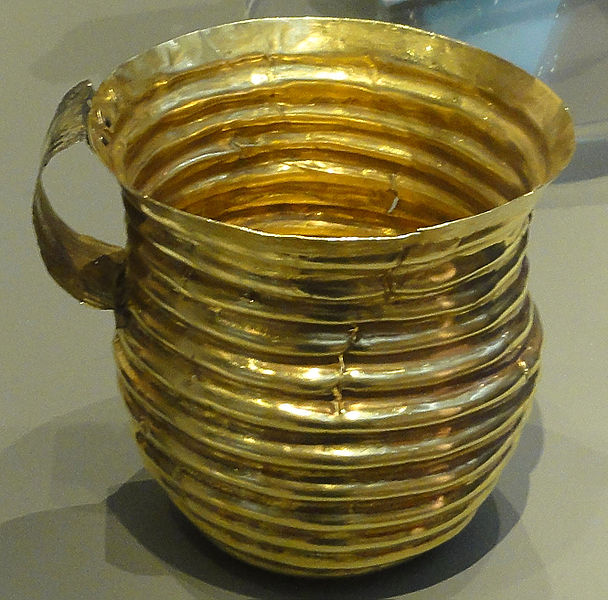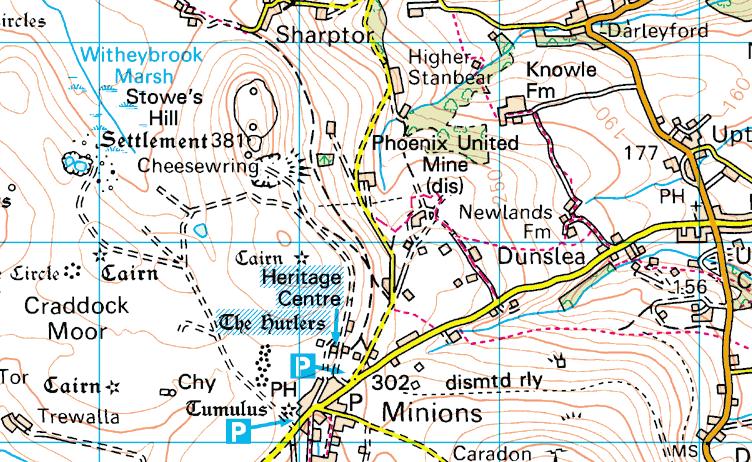The Golden Ghost of Mold #6: A Cornish Parallel July 28, 2014
Author: Beach Combing | in : Ancient, Contemporary, Modern , trackbackThe Rillaton Cup was a prehistoric gold beaten vessel that was discovered in a barrow in Cornwall (the cairn on the map below to the north east of the Hurlers). It is beautiful and antiquarians have compared it to the fabulous Mold cape, which is probably roughly contemporary. However, there is another connection between the Rillaton Cup and Mold Cape and that is associated archaeological ghosts. We went into excruciating detail about the Mold discovery in posts a couple of years ago: follow the golden ghost tag for more. For now though let us summarise as follows. At Mold there was a legend of a ghost dressed in gold that went into the barrow: the subsequent discovery then confirmed this ghost story (kind of). At Rillaton there is a similar tale, in fact, a tale that is incredibly similar. There was a druidic phantom at Rillaton:
There are many stories of passing travellers being waylaid by the phantom and offered a drink from a golden cup that can never be emptied. One story has it that a weary traveler tried to drain the cup and, when he found it impossible to do so, much to the amusement of the ghost Druid, he threw the contents of the cup in the spectre’s face, remounted his horse and resumed his journey. Shortly afterwards the bodies of both traveler and horse were found dead at the bottom of a ravine. [this from Peter Underwood’s Where the Ghosts Walk, 2013]
There are broadly speaking three possibilities here. (i) This is fake lore that Underwood had picked up at fourth or fifth hand. (ii) This was a nineteenth-century reaction to the discovery of the golden cup. (iii) As possibly with Mold the story may predate the discovery.
Having been through all the sources I think I’ve found the Ur source for this tale in print: though who knows how long the oral version had been kicking around: I would bet not more than fifty years? This comes from a Cornish journal and relates to an 1895 field trip.
The Cheesewring and the prehistoric remains near it were explored, after a capital luncheon at the Cheesewring Hotel. Mr. Harris, superintendent of the Caradon Railway, added much to the interest of the visit by his explanations and local information, A visit was first made to what is known as the Rillaton Barrow — so named from the manor on which it is situated — in which a remarkable gold drinking cup was found in 1837. Mr. Iago produced an enlarged drawing of it. It is 3 3/4 inches in height, and the bullion value of it is £10. Mr. Harris stated that before the cup was found there was a curious legend current in the neighbourhood. Whenever hunters came round that way, the Arch Druid would receive them sitting in his chair, and would offer them drink out of a golden goblet; and if there were forty or fifty of them, they could all drink from the cup without emptying it. One day a party were hunting the wild boar in the Widdecombe Marsh, to the west of the Cheesewring, and one of their number took an oath, or laid a wager, that if the Druid was there then, he would drink the cup dry. They thereupon saw the locks of the priest floating in the air, and hastened up to him. The hunter drank of the cup until he could drink no more, and was so enraged at his inability to finish it that he dashed the wine in the face of the Druid, who immediately disappeared. In connection with this legend, it is curious that within a quarter of a mile of the traditional seat of the Druid this gold cup was found. Journal of the Royal Institution of Cornwall XIII (1895) ‘The Annual Excursion’ 21-22
Can anyone push the story further back? drbeachcombing AT yahoo DOT com
31 July 2014: Borky writes: ‘Beach, livin’ jus’ down the road from Calderstones Park an’ a number o’ surroundin’ streets named for the Druids an’ their supposed stones contained therein I’m not unhappy with the idea some o’ these cup bearin’ Druidly ghosts reflect the newly emergent obsessions of the era. I do tho’ dispute the idea asserted by some onliners the fact some some o’ the associated artifacts seemingly belong t’ pre-Druidical eras prove the stories’re recent or/and ghosts whatever they are’re utter tosh. ‘Druid’ here’s surely a popular generic term o’ the period [like UFO] for ‘some eldritch apparition decked out in weird garb reekin’ o’ time out o’ memory’. Most people back then just as t’day couldn’t tell the diff’rence between a Druid or a much earlier Mycenean Bronze Age visitor [their obvious confusion elicited as proof o’ their chicanery an’ insanity]. As for the story’s antiquity almost a millennium ago Gervase Tilbury wrote o’ thirsty knights quenchin’ themselves by means of horn quaffing fairies or other tempters of the *knight*. It’s arguable the meme’s as old as the suppose sources behind the likes o’ the Grail an’ its many many predecessors. But why’ve such stories continued t’regenerate themselves for countless millennia right t’ the disposable vendin’ machine coffee cup present? I meself based on pers’nal experience’d argue the obsession o’ alchemists t’ work with matter in gen’ral an’ gold in particular an’ the highly disputed abilities o’ supposed psychometrists hints at some sort o’ sensitivity certain people might have for certain types o’ matter in certain types o’ forms under certain conditions. But I’ll leave you here by drawin’ your attention t’ the oddity the Mold Cape’s association with a *ghost* beholdin’ old lady whilst the Rillaton Cup amongst other assorted drinkin’ vessels’s associated with virile chaps astride virile horses all three o’ which’re found prominently displayed in cornucopia like abundance amongst the very constellations.’ Thanks Borky!




